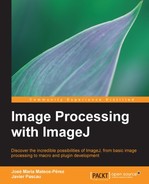Let's stick with the image we just opened for a while, as it will be a good template for the next exercise. If we want to zoom in or out of a given image, we can run the Image | Zoom | In [+] and Image | Zoom | Out [-] menu options. It is much easier to use the shortcuts, (+) and (-). The current zoom level is added to the image title bar if it is different from 100 percent (recheck the figure shown when we opened happy_face.jpg, and you will find the zoom level set to 50%). Now we can try zooming in and out of the tuberculosis_sample.tif file; the position of the mouse pointer on the image helps guiding the zoom in operation, since it is used to center the scaling. When the zoom level is too big, the main window stops getting bigger and the image is cropped. Two purple squares help the user keep track of the location inside the image. When this zoom level has been reached, you can keep the space bar pressed and drag the image around.

Zoomed image displayed when Interpolate zoomed images option is unchecked (left), and checked (right). Detail of the zoom guide overimposed on the image. Note the zoom level (1600 percent) on the title bar.
When an image is zoomed in, individual pixels will be displayed (left screenshot) or interpolated (right screenshot) depending on the Interpolate zoomed images option value available in the Edit | Options | Appearance... menu.
You can always check the values of the individual pixels that make up your image. When you move the mouse pointer over the image, ImageJ will show the corresponding image coordinates and pixel value in the status bar (below the menu and the toolbar). The image coordinates are measured in pixels, or whatever unit has been indicated in the image metadata. The spatial units can be set using Analyze | Set Scale.... This way, you can indicate a specific distance in pixels (if you have created a Straight line with the corresponding tool, its pixel length will be automatically loaded), and the corresponding spatial measure (in mm for instance). Now, every time you move over the image, the "x" and "y" coordinates will be measured using that unit. Pixel intensities follow a similar convention. They can be calibrated for your image, or you may indicate which pixel intensities correspond to whatever intensity units you may use (optical density, radiotracer concentration...) using the Analyze | Calibrate menu.
In order to better understand how all this works, open the sample image named CT (the ct.dcm.zip file) that corresponds to a DICOM file (a format used for medical imaging). This image is scaled in spatial dimension and calibrated in pixel intensities. When you move the mouse over it, you will see the "x" and "y" coordinates in mm, the calibrated pixel value, and the original pixel value stored in the file in parentheses:

Sample image CT.dcm showing the coordinates (in millimeters, as the image is calibrated) and pixel value of the current cursor position (white cross at the bottom right).
